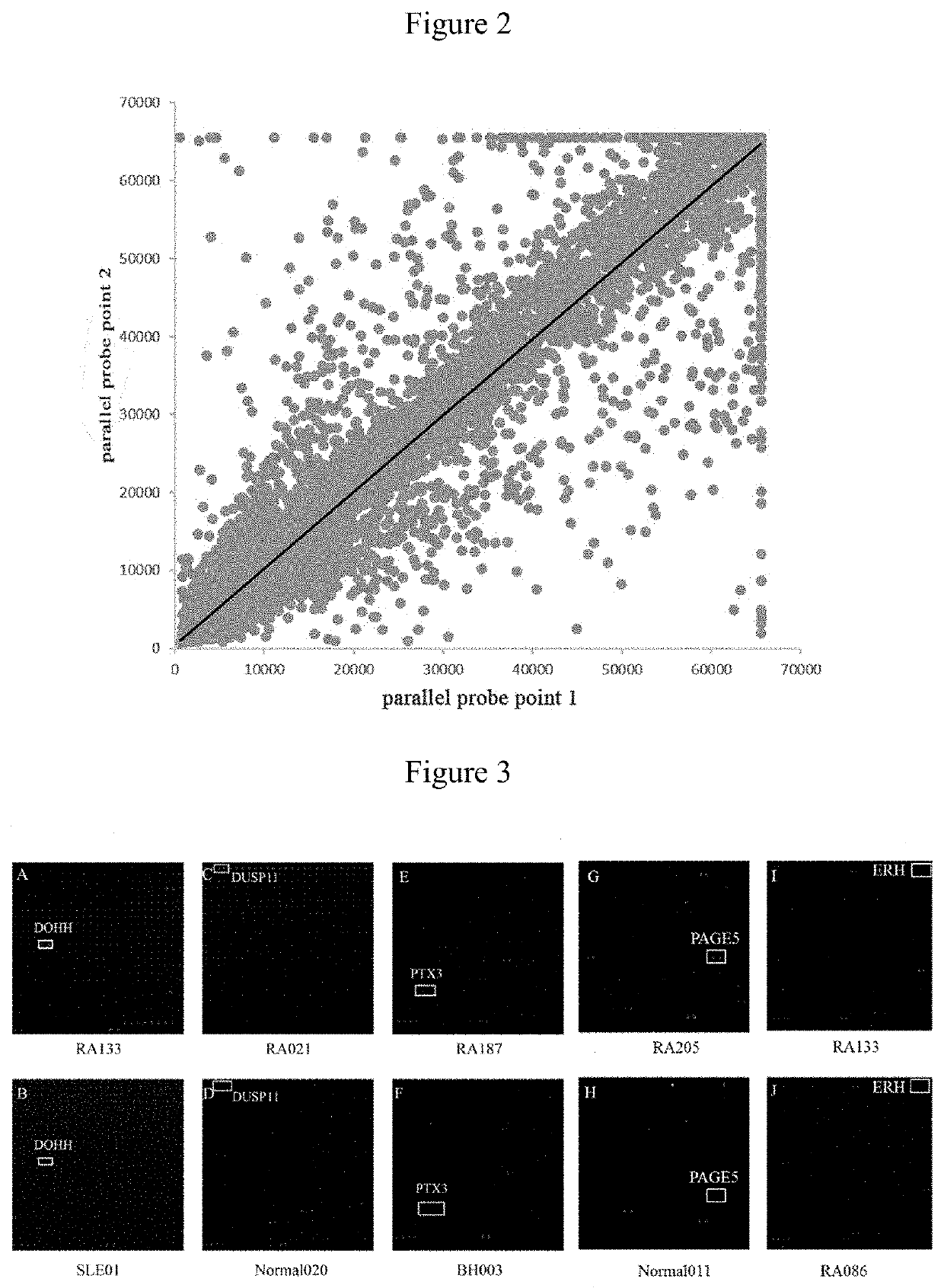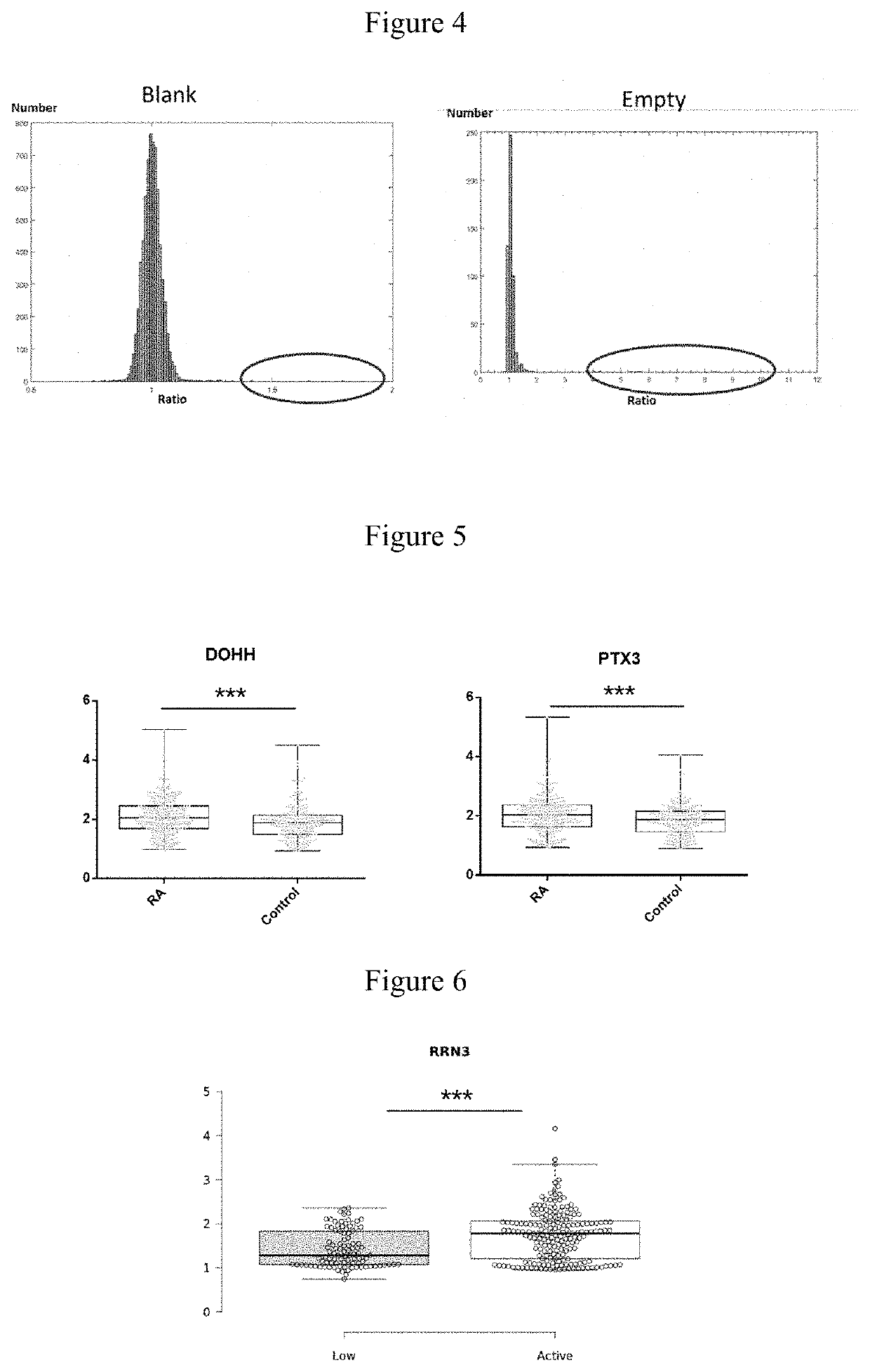Acpa-negative ra diagnostic marker and application thereof
- Summary
- Abstract
- Description
- Claims
- Application Information
AI Technical Summary
Benefits of technology
Problems solved by technology
Method used
Image
Examples
example 1
Identification of Candidate RA Autoantigens Using High-Density Protein Chips
[0053]The high-density protein chips and Saccharomyces cerevisiae-expressing recombinant vectors including target gene sequences were provided by Dr. Zhu's laboratory at Johns Hopkins University. Each chip consisted of 48 blocks and the block included 992 probe points arranged in a 32*31 array, with 2 parallel points for each protein probe. The protein chip consisted of 21827 non-redundant recombinant human proteins. The recombinant proteins, with glutathione S-transferase (GST) tag at the N-terminus, were derived from the full-length open reading frame (ORF) of the corresponding gene expressed by Saccharomyces cerevisiae.
[0054]The quality of chips was verified by hybridizing mouse anti-GST monoclonal antibodies with the chips. Qualified repeatability of duplicate protein spots was achieved when the correlation coefficient of fluorescent signal value between duplicate spots reached 97%.
[0055]Each high-densi...
example 2
Hybridization of High-Density Protein Chips, RA and Control Serum
[0056]60 RA and 60 control (10 BD, 10 TA, 10 SLE and 30 healthy controls) serum samples were hybridized with 120 protein chips, and candidate RA autoantigens were identified by signal collection and data analysis. PE-Cy5 labeled anti-human IgG antibody was used to detect the reaction between the serum autoantibodies and autoantigen probes. FIG. 3 shows the representative partial scan image formed by serum hybridization with high-density protein chips, different protein antigen probe is shown in the box. A, C, E, G show scan images of hybridization of 4 RA serum samples with chips. B, D, F, H show scan images of hybridization of 4 control serum samples (including disease and healthy controls) with chips. FIG. 1 shows the scan image of RA treatment effective. Figure J shows the scan image of RA treatment ineffective. Two parallel points protein probes in the boxes of Figures A and B are DOHH, DUSP11 in the boxes of Figur...
example 3
Construction of RA Autoantigen Protein Chip and Verification of Serum Screening
[0062]By analyzing the result of hybridizing small number of serum samples with high-density protein chips, 46 candidate RA autoantigens were identified. To verify the specificity and sensitivity of these autoantigens, the present invention constructed low probe density RA autoantigen protein chip. Table 2 shows the distribution of microarray of each probe at RA autoantigens protein chip. The probes at the chip included 46 candidate RA autoantigens and 5 control probes (IGHG1).
TABLE 2Microarray of each probe at RA autoantigens protein chipAK2IGHG1NDATP13A5NDTBC1D19RAB35UBXN10RAB3DAPH1ATNFAIP1HDAC4ARL2BPRAI14RRN3POLR3BERHNDRG1BLANKBLANKBLANKBLANKBLANKGARSSUGT1IGHG1NOL3ZSCAN20LSP1RGCCEMPTYPAGE5FGF12FAM84ADOHHNECAB1NDEL1DUSP11PDCD2MYLKSTK24METTL21CIGHG1STK3BABAM1DGKKPTX3PPFIA4EMPTYSPANXN2IGHG1CHAC2RNF183ATXN10IGHG1EMPTYCHST11PLEKHG2SNX33BLANK
[0063]51 probes at RA autoantigen protein chip all had duplicate po...
PUM
 Login to View More
Login to View More Abstract
Description
Claims
Application Information
 Login to View More
Login to View More - R&D Engineer
- R&D Manager
- IP Professional
- Industry Leading Data Capabilities
- Powerful AI technology
- Patent DNA Extraction
Browse by: Latest US Patents, China's latest patents, Technical Efficacy Thesaurus, Application Domain, Technology Topic, Popular Technical Reports.
© 2024 PatSnap. All rights reserved.Legal|Privacy policy|Modern Slavery Act Transparency Statement|Sitemap|About US| Contact US: help@patsnap.com










